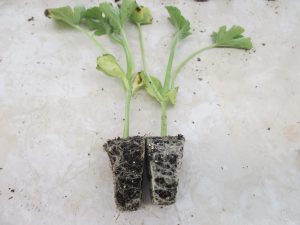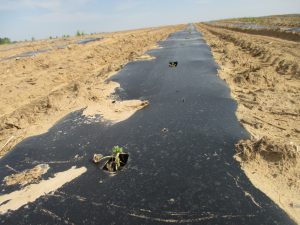Last week, we were called by a few watermelon growers who reported their newly planted watermelon seedlings were dead (Figure 1 ). After closely inspecting the affected plants, we did not find any pathogens. This reminded us of what happened to our cucumbers back in early April in our high tunnel. We will review the cucumber story first, and rethink what might have happened to the watermelons.
Cucumbers were planted on March 30 in a high tunnel located at Southwest PurdueAgricultural Center (SWPAC), Vincennes, IN. The lowest air temperature after planting was recorded at 37.5°F inside the high tunnel, which should not be low enough to cause frost damage. However, we lost 40% to 80% of the newly planted cucumbers depending on varieties. The symptoms were similar to water deficiency-caused plant wilt (Figure 2 ). Most of the dead plants had intact stems, however, we did find wire worms in the stems of a few dead plants. We drenched the soil with Admire® on April 8. Plants were reset on April 9.
Unfortunately, almost all the reset plants died again. The soil was moist, no pathogens were found, and most of the stems were free from the wire worm damage. Why did the plants wilt? Because when soil temperature is below 63°F, the ability of cucumber roots to absorb water is greatly inhibited. As a matter of fact, between March 30 and April 10, more than half the time the soil temperature inside the high tunnel was below 60°F, in the range of 52°F to 67°F. Interestingly, grafted cucumbers with cold tolerant rootstocks all survived at the first planting in the same high tunnel. The dead plants were replanted again on April 14, when soil temperature inside the high tunnel finally stabilized above 70°F, and all the seedlings survived.
Were the watermelon transplant symptoms we observed also caused by low soil temperature? let’s take a look at the bare-ground soil temperature recorded at SWPAC in the past weeks (Figure 3 ). Starting from May 1, average bare soil temperature did not rise above 70°F until May 24. From May 15 to 19, soil temperatures were the lowest. The average bare soil temperature was between 60 and 63°F. Coincidently, the most severely damaged watermelon fields were planted during this time period. It is true that black plastic mulch is expected to increase soil temperature. However, considering the constant rains that occurred in early May, it is likely the plastic was not laid until recently, and the cloudy days were not help at all. What other factors might contribute to the transplant failure? We noticed the transplants did not have a solid root ball when they were planted (Figure 4). These plants might survive if environmental conditions are ideal. However, under the adverse soil temperature, the weak transplants are more than likely to suffer first.

Figure 4. Watermelon transplant on the left has a loose root ball compared to transplant on the right. Note the above ground plants are in similar sizes.
We cannot control the weather, but there are a few points we should learn from this year’s lessen: 1. If possible, do not plant if anticipated soil temperature is below 65°F at the time of planting; 2. If possible, using transplants that have developed a solid root ball; 3. Lay plastic early in the season to ensure adequate heat accumulated under plastic.
What happened in this season also raises a few research questions that warrant exploration: 1. whether watermelon varieties differ in their tolerance to low soil temperature, considering that varietal difference do exist among cucumber varieties. 2. what are the threshold soil temperatures for watermelon transplant establishment? 3. Whether grafting can be an approach to combat with low soil temperature in watermelon production? Hopefully, we could find answer to the questions in our future researches.


